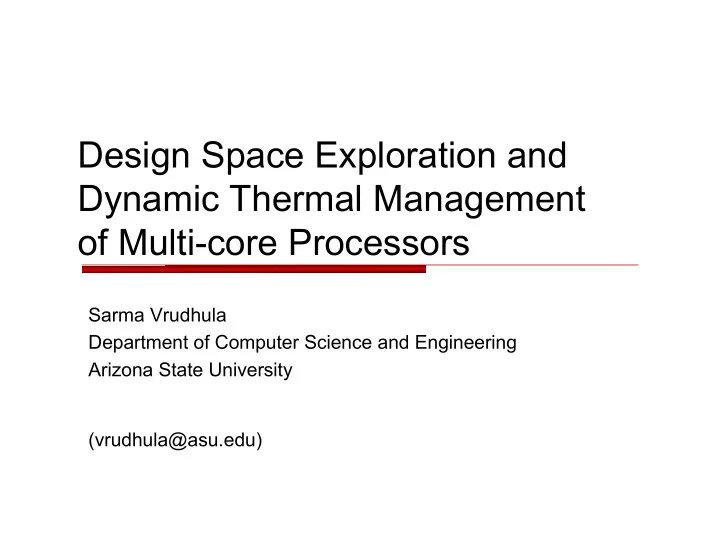

Design Space Exploration and Dynamic Thermal Management of Multi-core Processors Sarma Vrudhula Department of Computer Science and Engineering Arizona State University (vrudhula@asu.edu)
Thermal Management (TM) for Multi-core • Single or "few" cores: • DTM (clock gating, fetch throttling, DFVS, thread migration . .) employed infrequently, when temperature exceeds preset threshold • Package & cooling solution designed to handle worst-case power • With "many" cores • large temporal variations in # of threads executing, hence, in power consumption • Not feasible to design package to remove worst-case power, but closer to average power • DTM will be used more frequently and will have a much greater impact on performance when compared to single cores • Need to account for coupled relation between power, speed and temperature 1
Speed, Power & Temperature
Hotspot thermal model N = 2nm + 14 blocks
Hotspot RC Circuit Model
Design Space Exploration • What is the maximum number of cores that can be activated with and without throttling in steady-state? • What is the steady-state throughput and power as a function of the number of active cores ? Answers in terms of Static and dynamic power consumption of hottest block and full chip thermal resistances of hottest block leakage sensitivity to temperature ambient and chip threshold temperature DSE requires requires fast and scalable (simple algebraic expressions) answers
Design Space Exploration 2
Dynamic Thermal Management
Steady-state problem formulation (t’put = weighted sum of speeds) (steady-state thermal equation) (thermal constraint) (speed boundaries for each core) LP: n decision variables, 2nm+14 constraints
Transient speed control problem (time-averaged throughput) (transient thermal equation - linear LDT) Optimal control problem: n control variables (speeds), 2nm+14 state variables (temperature). Too big for analytical solution. Very expensive to solve numerically.
DTM Extensions Stochastic Workloads: • to model inexact nature of program execution and nondeterministic memory access patterns • can be included in the existing framework by modeling the power consumption as a random process Dynamic Task Allocation: Need fast (within OS scheduling interval) schemes to migrating threads between heated cores Process Variations: Requires modeling the circuit & thermal parameters as realizations of spatial stochastic process Inter-core variations for the thermal parameters (Rs & Cs) Circuit parameters (Tox, Leff, Vt) have both intra-core and inter-core variations. Major impact on core leakage
DTM Extensions • Real-time Scheduling: Compute optimal speed profiles when tasks have hard deadlines, requiring minimization of makespan • Modeling of Interconnects: Interconnect power for 16 cores can be more than the combined power of 2 cores Variations in interconnect will exhibit significant variations in power • Micro-architecture Components Incorporating dynamic and leakage parameteric models of micro- architectural components
Recommend
More recommend